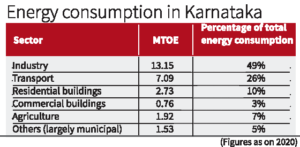Published on: August 31, 2023
Karnataka State Energy Efficiency Action Plan
Karnataka State Energy Efficiency Action Plan
Why in news? According to report prepared by Bureau of Energy Efficiency in association with Karnataka Renewable Energy Development Limited (KREDL), more Electric Vehicles in Karnataka can result in energy savings, reduce greenhouse gas emissions.
Highlights:
- The Confederation of Indian Industry (CII) has been appointed as the technical consultant for the preparation of the action plan that offers a short-term plan for five years and a long-term plan for high-impact energy efficiency by 2031.
- Initiative will provide a comprehensive roadmap that leverages Karnataka’s strengths in renewable energy and energy conservation
About Karnataka in Energy Efficiency Action Plan
- Karnataka ranks first in India in energy conservation
- State bagged the first rank in ‘State energy efficiency Index’ during 2019-20 and FY 2021-22
- This initiative to draw out an action plan comes in the backdrop of PM’s pledge at the Conference of Parties (COP 26) in Glasgow to reduce India’s projected carbon emissions by one billion tonnes by 2030.
What are the main findings of the study?
- It has identified the top five energy-consuming sectors in the State based on their total final energy consumption as of 2020 – industry (49%), transport (26%), building (13%), agriculture (7%) and municipal (around 5%).
- The study has considered increasing the share of EVs on the road, including two-wheelers, three-wheelers, cars, buses and heavy vehicles, across the State to 24 lakh by 2031
- It has set the target of EV penetration to 41 lakh vehicles by 2031.
- For potential energy savings, 70,000 additional charging stations and battery swapping infrastructure are necessary in the moderate scenario and 1.15 lakh units under the ambitious scenario with Level-1, Level-2 and Level-3 (DC) chargers across all cities.
- It has also been reported that the final energy consumption increased by a compound annual growth rate (CAGR) of 4.6% in the State between 2015-2020.
- Replacing inefficient appliances like fans, AC, washing machines, refrigerators, televisions, and geysers with new ones will cut down on the power bills of consumers that also mitigate GHG emissions and promote sustainable development.
The aim of the report
- To provide technical assistance for the identification of focus sectors in the State
- To ensure that the allocation of resources is as per the requirement of the State
- Estimate the potential of energy conservation in the identified sectors.

